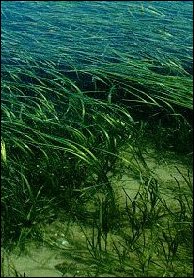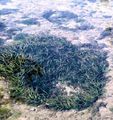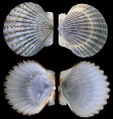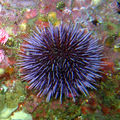Seagrass meadows
This article describes the habitat of the seagrass meadows. It is one of the sub-categories within the section dealing with biodiversity of marine habitats and ecosystems. It gives an overview about the characteristics, distribution, zonation, succession, biota, threats, functioning and adaptations of the organisms that live in seagrass meadows.
Contents
Introduction
Seagrass communities are highly productive and dynamic ecosystems. Seagrasses are not true grasses but rooted vascular (flowering) plants of terrestrial origin that have successfully returned to the sea. This return needs several adaptations that allow them to live in submerged ocean regions. The sediments where they settle on can be muddy, rocky or sandy. Seagrass ecosystems are species rich and include endangered species such as dugongs and seahorses. They are very important for the geomorphology and ecology of coastal ecosystems by processes such as stabilizing sediments, recycling nutrients and forming the base of the oceanic detrital food webs. Currently, they are facing many threats, induced by humans and nature. [1]

Distribution
Seagrasses generally inhabit the protected shallow waters of temperate and tropical coastal area. The most extensive areas are found in the tropics. A few species occur in colder regions. World wide 60 species exist, but only 4 species are native of European waters. These species are closely related. There are several distinct areas of seagrass meadows. These areas are Indo-Pacific, central-America, the seas around Japan and Australia and the Mediterranean Sea.
Zostera marina is found from arctic waters along the northern Norwegian coast to the Mediterranean Sea. It is very abundant in the Baltic Sea, the North Sea and along the Atlantic coast to northern Spain.
Zostera noltii ranges from the southern coast of Norway to the Mediterranean Sea, the Black Sea, the Canary Islands and has even been recorded on the southern coast of Mauretania.
Cymodocea nodosa is found in the Mediterranean Sea, the Canary Islands and the North African coast. It is a warm water seagrass.
Posidonia oceanica is restricted to the Mediterranean Sea. The distribution of it stops where the Mediterranean water and the Atlantic water mix.
Other species may successfully invade in European waters if seeds or fragments are accidentally introduced. These days, Halophila stipulacea is invading in the eastern Mediterranean and has reached the southern coast of Italy. [3]
Requirements for development
Seagrasses have several requirements to develop:
- Salt or brackish water is absolutely necessary.
- They need enough light for photosynthesis. They need an excess of 11% of the incident light in the surface water. Therefore, they grow in the shallow regions along the coasts and depth limits are set. The average depth is a few meters , but they are recorded to 70 meters in clear water.
- When the water becomes too turbid (sediment suspension), the plants and their dependant organisms can be destroyed. For an optimal growth, the plants need clear water.
- They need a soft substrate such as mud or sand, but some species can also grow on rocky sediments and corals.
- The most suitable place is a gently sloping coast, with little or no tidal currents or strong waves.
Zonation
Different species grow in different places. This causes zonation. The first zones are the high and mid intertidal. This is situated just below the mangrove vegetation. The colonization species are Halodule wrightii and Cymodocea rotundata on more stable substrates with some sand-dwelling seaweeds such as Chondria, Hypnea and Caulerpa.
The mid and low intertidal are dominated by the climax vegetation Thalassia hemprichii on stable substrates. Numerous Pinna and some seaweeds are present close to the low water margin.
The subtidal fringe is an area with Syringodium isoetifolium. This seagrass has tough, cylindrical leaves. Enhalus acoroides sometimes occurs here. This seagrass also has very large and tough leaves.
In the subtidal, the species Halophila stipulacea and Halodule uninervis occur on new substrates. On stabilized substrates, Thalassodendron ciliatum and Enhalus acoroides grow.
European genera are Zostera, Posidonia and Cymodocea.
Zostera or eelgrass is a small genus of widely distributed seagrass, with Z. marina and Z. noltii occurring in Europe. It is found on sandy substrates or in estuaries submerged or partially floating. The meadows are important for sediment deposition, substrate stabilization, as substrate for epiphytic algae and micro-invertebrates and as nursery grounds. Z. marina is a subtidal species and may grow down to 10-15 meters depth. Z. noltii forms dense beds in the muddy sand of intertidal areas. Z. marina is in this area rare because of its lower tolerance to dessication. Z. noltii can also occur in subtidal areas, but is usually outcompeted by other seagrasses.
Posidonia oceanica is another European species. It is endemic to the Mediterranean Sea. They occur in dense meadows or along channels in sands. On beaches, balls of fibrous material from the foliage of the plant can be found. This is known as egagropili. It grows from shallow subtidal waters to depth of 50-60 meters in areas with very clear water.
Cymodocea nodosa is a seagrass that occurs in the Mediterranean Sea. It can be found from shallow subtidal to waters with a depth of 50-60 meters. [5]
Zostera marina [6]
Zostera noltii [7]
Posidonia oceanica [8]
Posidonia oceanica egagropili [9]
Cymodocea nodosa [10]
Succession
The first stage of the succession starts with unicellular algae. These algae are mainly diatoms and sticking the sediment grains together by mucus. After this stage, filiform algae take over. They provide a better fixation of the substrate. These algae are mainly blue-green algae or Cyanophyta. After a while, the colonizing species start to germinate and grow. These species are especially opportunists that grow fast and have long internodes. This provides a fast formation of a network of stolons. Species are Halophila ovalis, Halodule wrightii, Halophila stipulacea and Halodule uninervis. In the intertidal zone, pools are formed by grazing activities of turtles. The margins of these pools are overgrown by seagrass species. Cymodocea species take over. They have shorter internodes, more fleshy roots and can better fixate the sediments. Finally, Thalassia hemprichii settles. They have very short internodes, densely branched stolons and numerous fleshy roots. This results in very dense vegetation. This is called the climax vegetation. The European species are the same as in the zonation-section.
Unicellular algae (diatoms[11]
Halodule wrightii[11]
Pools created by grazing turtles [11]
Cymodocea rotundata [11]
Thalassia hemprichii[11]
Functioning and adaptation
The seagrasses have adapted to the marine environment in several ways:
- They are physiologically adapted to seawater
- They are able to grow under submerged conditions. They are called hydrophytes. For this reason, the tissues of the seagrasses consist of aerenchyma. Through this aerenchyma, air can be provided to the submerged parts of the plants. Another adaptation to these conditions is that the seagrasses have an epidermis with chloroplasts. This is exceptional because the other higher plants lack chloroplasts. Above this epidermis, a very thin cuticle is present. This provides the uptake of nutrients through the whole leaf surface. Stomata’s are absent. Little transport is needed because the nutrient uptake is carried out by the whole leaf surface. Therefore, the vascular bundles are strongly reduced.
- They are resistant to erosion by waves and tidal currents. This is due to the well developed rhizomes and numerous, fleshy roots that anchor into the substrate. The supple leaves are better resistant to water movement than stiff leaves.
- The pollination is provided by the water. The pollen is released from the flowers in gelatinous clumps that are carried by water currents to the pistils (female reproductive organ). They also have seed dispersal.
The major stems of seagrasses are called rhizomes. They grow horizontally, mostly just below the surface of the substrate. Together with the roots, they help stabilizing the substrate. The leaves and the roots function as sediment traps. Nutrient uptake from the seawater is very efficient. This is called nutrient-stripping. An important function of the seagrasses is that they determine the quality of the coastal waters. The roots are thicker and more fleshy than the fibrous roots of terrestrial grasses. Further, they are important nursery grounds for commercial fish species. They also provide protection against coastal erosion, absorb [math]CO_2[/math] and are a good filtering system. For many organisms they are an important shelter. They also are important primary producers, together with the epiphytic algae. [12]
Biota
In the dense seagrass meadows, a wide variety of organisms are fouling such as hydroids, sponges, bryozoa and seaweeds. These organisms mainly attach on older leaves. Many invertebrate species are dependant of seagrasses and would become extinct or greatly reduced in abundance if the seagrasses disappear. An example of the importance of the seagrasses for the survival and development is the Atlantic bay scallop Argopecten irradians. This scallop needs the seagrass habitat for the development of its larval stage and the juveniles are protected from predators. The dense meadows can also discourage predators from entering it. Most seagrasses are not directly consumed by herbivores, because they are too tough. Species that do graze on the seagrasses are sea urchins, sea turtles, dugongs, manatees, some fishes and waterfowl. Filter feeders are abundant in the sediment. Some examples are scallops, jackknife, clams and sea cucumbers. [13]
Threats
The declining population of seagrasses is a worldwide trend. This can be the cause of several natural and human disturbances. Over the last 2 decades, the estimated loss from direct and indirect human impacts amounts to 18% of the documented seagrass area. But this is a small fraction of the actual numbers, because many losses remain unreported. In their turn, seagrass loss leads to a loss of the associated functions and services in the coastal zone. [17]
The causes of this declining trend are:
- Coastal pollution
- Natural disturbances such as grazing, storms and desiccation
- Dredging for harbors, ports and shipping lanes
- Beam trawl fishing and overfishing
- Aquaculture: shading, eutrophication and sediment deterioration
- Eutrophication: excessive input of nutrients is toxic to seagrasses
- Clearance for beaches
- Shipping: anchoring, pollution
- Introduction of exotic species; accidentally, ballast water, aquaculture, hull fouling
- Tourist facilities
- Global warming, sea level rise, [math]CO_2[/math], UV increase
See also
Invertebrates in Posidonia sea-grass meadows [1]
References
- ↑ Denny M.W. Gaines S.D. 2007. Encyclopedia of tidepools & rocky shores. University of California Press. p. 705
- ↑ NOAA
- ↑ Borum J. et al. 2002. European seagrasses: an introduction to monitoring and management. The M&MS project. p.95
- ↑ UNEP-WCMC (World Conservation Monitoring Centre) 2001
- ↑ Borum J. et al. 2002. European seagrasses: an introduction to monitoring and management. The M&MS project. p.95
- ↑ http://www.algaebase.org
- ↑ http://www.ru.nl/wetenschapsagenda/editie_19_-_18_06_08/nieuws/vm/jaargang_een/grootschalige/
- ↑ http://www.algaebase.org
- ↑ http://mallorcaphotoblog.wordpress.com
- ↑ http://www.algaebase.org
- ↑ 11.0 11.1 11.2 11.3 11.4 Eric Coppejans - http://www.vliz.be/imis/imis.php?module=person&persid=134
- ↑ Karleskint G. 1998. Introduction to marine biology. Harcourt Brace College Publishers. p.378
- ↑ Levinton J.S. 1995. Marine biology: function, biodiversity, ecology. Oxford University Press. p. 420
- ↑ Bill Frank
- ↑ Greenpeace
- ↑ Ian Craig
- ↑ Duarte C.M. 2002. The future of seagrass meadows. Environmental Conservation 29:192-206
Please note that others may also have edited the contents of this article.
|












